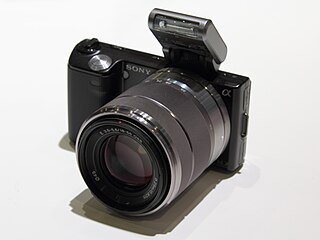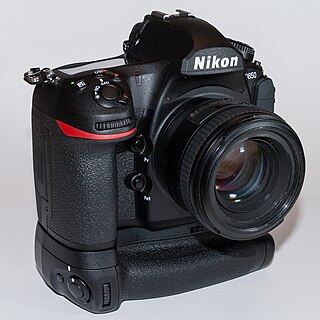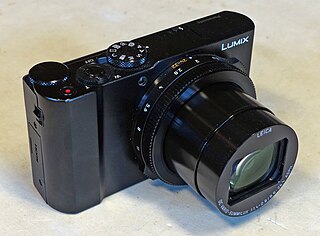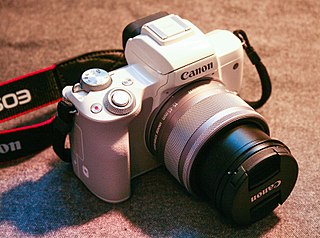
The Sony α NEX-5 is a digital camera launched on 11 May 2010. It is a mirrorless interchangeable lens camera with the body size of a larger model fairly compact point-and-shoot camera with a larger sensor size (APS-C) comparable to that of some digital single-lens reflex cameras. Its major competitors in the market are the cameras based on the micro 4/3 standard created by Panasonic and Olympus, and a few low end Canon, Nikon, and even Sony α DSLRs. The NEX-5 shoots 14.2 megapixel stills and has a 7 frame/s continuous shotmode. It has the capability to shoot 1920×1080i at 60 frame/s in AVCHD or 1440×1080p at 30 frame/s in MPEG4. The NEX-5 was replaced by the 16 megapixel NEX-5N in August 2011.

The Canon EOS 60D is an 18.1 megapixels semi-pro digital single-lens reflex camera made by Canon. It was announced on August 26, 2010, with a suggested retail price of US$1099.00. As a part of the Canon EOS two-digit line, it is the successor of the EOS 50D and is the predecessor of the EOS 70D.

Single-lens translucent (SLT) is a Sony proprietary designation for Sony Alpha cameras which employ a pellicle mirror, electronic viewfinder, and phase-detection autofocus system. They employ the same Minolta A-mount as Sony Alpha DSLR cameras.

The Sony α55 is a midrange-level SLT camera, released in August 2010.

The Panasonic Lumix DMC-GH2 is a digital camera with HD video recording capability that is part of the Micro Four Thirds system. Though commonly referred to as a DSLR camera, it has no mirror or optical viewfinder, but has instead both a fold-out LCD screen and a electronic viewfinder.

The Sony α77 was the flagship for Sony's midrange Alpha SLT camera line.

The Sony α37 or Sony Alpha 37 is a single-lens reflex style digital camera that replaced the SLT-A35 in 2012. However, the Alpha 37 camera features an electronic viewfinder and a translucent mirror. The main advantage of a translucent mirror is that it needn't flip up out of the way when taking a picture in order to expose the sensor, but the camera can focus and capture images simultaneously. Also the viewfinder can be used while video recording or stills/video playback, which is useful for example in bright sunlight. The camera's 15-point autofocus system can be set to single, continuous or automatic and is arranged towards the centre. The 7 fps burst mode is available only in "speed priority" mode but can reach up to 5.5 fps burst rate in combination with any other settings. The A37 is compatible with Sony Bravia Televisions.
The Sony Cyber-shot DSC-RX100 series is a high-end compact camera part of the wider Sony RX series. It started with the DSC-RX100, announced on 6 June 2012, and is part of the Cyber-shot RX line of digital cameras made by Sony. Seven annual generations have been released so far until 2019, all equipped with a one-inch 20-Megapixel image sensor and rotary knob around the lens. Filming at up to 1080p at 60fps is supported by the first three generations, the third additionally with 720p at 120fps, and up to 2160p (4K) at 30fps and 1080p at 120fps high frame rate video since the fourth.

The Nikon D7100 is a 24.1-megapixel digital single-lens reflex camera model announced by Nikon in February 2013. It is a 'prosumer' model that replaces the Nikon D7000 as Nikon's flagship DX-format camera, fitting between the company's entry-level and professional DSLR models. This camera is the first ever from Nikon with no optical low-pass filter incorporated. At launch, Nikon gave the D7100 estimated selling price in the United States as US$ 949.95 for the body.

The Canon EOS 100D, known as the EOS Rebel SL1 in the Americas and EOS Kiss X7 in Japan, is an 18.0-megapixel digital single-lens reflex camera announced by Canon on 21 March 2013. It has been described as the "world's smallest and lightest DSLR camera", either currently in production or in the APS-C format. Canon uses a smaller version of the APS-C sensor format than some other manufacturers including Nikon, Pentax, and Sony, with a crop factor of 1.6 rather than 1.5. It weighs 407 grams including battery and memory card.

Announced by Sony on August 24, 2011, and launched alongside its brother the Sony Alpha 77, the Sony Alpha 65 is the top-tier for Sony's midrange Alpha SLT camera line.

The Sony α58, Sony Alpha 58 also known as Sony A58 is a mid-range digital camera from Sony's Alpha SLT camera line, introduced in 2013.

The Sony Alpha 77 II (ILCA-77M2), stylized as the Sony α77 II, is an interchangeable-lens camera aimed at the advanced amateur. It replaced the Sony Alpha 77 model in June 2014. It is similar in design to its predecessor, including the use of a SLT transparent mirror and electronic viewfinder.

The Canon EOS 750D, known as the Rebel T6i in the Americas or as the Kiss X8i in Japan, is a 24.2 megapixels entry-mid-level digital SLR announced by Canon on February 6, 2015. As a part of the Canon EOS three-digit/Rebel line, it is the successor to the EOS 700D and the predecessor to the EOS 800D.

The Sony RX is the name of a range of fixed lens compact point-and-shoot digital cameras created by Sony in 2012. All cameras are equipped with Carl Zeiss lenses.

The Nikon D850 is a professional-grade full-frame digital single-lens reflex camera (DSLR) produced by Nikon. The camera was officially announced on July 25, 2017, launched on August 24, 2017, and first shipped on September 8, 2017. Nikon announced it could not fill the preorders on August 28, 2017 and filled less than 10% of preorders on the first shipping day. It is the successor to the Nikon D810.

The Panasonic Lumix DMC-LX10 is a 20 MP 1" sensor compact camera in the Lumix range, announced by Panasonic on September 19, 2016. LX10 features an F1.4–2.8 equivalent Leica-branded zoom lens, 3" 1040k dot LCD, built-in flash, built-in wireless, and it can record 4K video at 30p or Full HD at 60p. The LX10 is more compact than the Panasonic LX100 or GX8 series by not having an electronic viewfinder, interchangeable lenses, or hot shoe. The camera is typically compared to the Sony RX100 series.

The Canon EOS M50 Mark II, also known as the EOS Kiss M2 in Japan, is a 24.1 megapixels entry-mid-level mirrorless interchangeable-lens camera announced by Canon on October 14, 2020. As a part of their Mirrorless Canon EOS M Line, it is the successor to the Canon EOS M50, sitting above the entry-level Canon EOS M200 and below the enthusiast-oriented Canon EOS M6 Mark II.

















